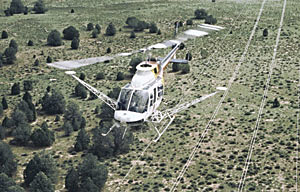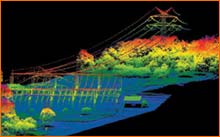| Applications of spatial data collection and
editing
 Recent
developments in the use of airborne sensors and geodata processing
applications have led to the creation of new types of cartographic
and spatial data, which allow for innovative solutions ensuring
collection speed and superior quality of spatial information. Recent
developments in the use of airborne sensors and geodata processing
applications have led to the creation of new types of cartographic
and spatial data, which allow for innovative solutions ensuring
collection speed and superior quality of spatial information.
Using the existing equipment (aircrafts and airborne sensors
and cameras), as well as the broad experience in the collection,
processing and management of spatial data, Geomatics offers
ground-breaking solutions based on the use of airborne sensors:
|
|
 Laser
Scanning Laser
Scanning
LiDAR (LIght Detection And Ranging) technology allows for
the collection of high density and high accuracy elevation
data using laser-beam scanning techniques. This method of
producing elevation information is ideal for the scanning
of both terrain and vegetation under any kind of weather conditions.
|
|
LIDAR Applications

- Production of Digital Elevation Models with densities
of up to 4 points per square meter.
- Forested area mapping, identification of vegetation height.
- Production of Digital City Models for telecom networks
and GIS applications. High accuracy 3D models for flood
simulation, as well as noise and pollution distribution
in urban areas.
- Digital Elevation Models for use in construction and mining
(road and railroad network projects, large scale earthwork,
surface mines) assisting in volumetric calculations.
- Rapid coastal area mapping, coastal erosion mapping and
change detection.
- Flooded area mapping - Flood simulation using high accuracy
DEMs.
- High-voltage power line corridor mapping, with precise
location of lines and towers. Surrounding area visualization
for the verification of clearance from the vegetation canopy.

|